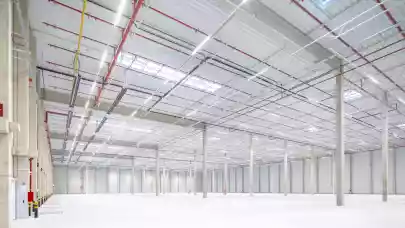
Rebounding industrial production and easing inflation are helping the Slovak economy to avoid recession. In the industrial market, it is visible robust construction growth and demand surge. The office sector is resilient but vacant subleased spaces are increasing, while the rental rates are stable amid yield increases. Nevertheless, Slovakia's retail sector is facing challenging dynamics as market limitations amplify alongside a cautious expansion trend, largely due to geopolitical and economic uncertainty, Cushman & Wakefield reports in its Marketbeat Analysis for Q2 2023.
Slovakia’s economy is emerging from a prolonged period of weak growth as the effects of adverse shocks are starting to wear off. Despite experiencing several quarters of relatively weak growth, this reflects the resilience of Slovakia's economy, particularly considering the technical recessions faced by major economic partners such as Germany and the Czech Republic. While inflation remains double-digit – 10.8% in June, it decreased by 3% in Q2, which was primarily driven by the deceleration in the rise of food prices and the decline in fuel costs and therefore energy prices. We expect core and food inflation rates to have peaked as base effects start to play a dominant role. In combination with a drop in real disposable incomes by 5%, this led to a decrease in consumer spending affecting the retail market. As global growth decelerates, office employment usually follows. Yet, Slovakia‘s low costs make it an attractive destination for companies seeking to outsource, expand, or relocate, particularly in times of squeezed profit margins. Accordingly, the labour market remains solid, and unemployment kept falling to 3.9% by the end of Q2. We saw all prime yields moving above 6.00% in Q2. This does not mean that an under-rented prime asset with above-standard WAULT could not attack lower yields in rare cases. Generally, a yield increase of 75 – 100 bps has already materialized reflecting general yield shifts in neighbouring countries and western Europe.
Industrial market
The industrial segment continues to surge forward, underpinned by resilient demand and the most robust pipeline in the last year. A total of 19 buildings, accounting for 321,300 sqm, are presently under construction. Half of this construction activity is concentrated in Western Slovakia, with Central Slovakia – an area historically underdeveloped yet increasingly popular – accounting for 67,400 sqm. Despite two-thirds of the under-construction stock being speculative, developers generally hesitate to engage in speculative development due to financing costs. However, in areas where availability of space is scarce, and persistent demand prevails, particularly with the trend of nearshoring, developers are willing to embrace the risk of speculative development. Demonstrating continued robust demand, overall gross and net take-up figures escalated by over 60% Q/Q, to reach 186,300 sqm and 125,700 sqm respectively. The primary drivers of demand remain the automotive industry (with a 40% share), followed by 3PL (25%) and FMCG (19%). Notably, there is a growing interest in producing solar panels and heat pumps. New supply, totalling 40,100 sqm and split across 5 buildings throughout Slovakia, took place mainly in Eastern Slovakia. The combination of strong demand and diminished supply led to a decline in the vacancy rate to 3.73%, and it is expected to hover around 4% for the remainder of the year.
In response to the evolving real estate landscape, land banks are being acquired and earmarked for future pipeline projects, notably in areas grappling with space availability. Unsurprisingly, escalating inflation and increased input costs, alongside robust demand, have incited a hike in headline rents across all submarkets. Developers are requiring higher headline rents in areas with a lack of vacant spaces, such as Trenčín, Dunajská Streda, Žilina and Prešov. Coupled with lease length exceeding 5 years required by landlords led to prime rent reaching 4.8 €/sqm/month and upward pressure on rents persists. With headline rates that are comparatively lower than other regional markets and emerging nearshoring trends, Slovakia's industrial segment is particularly enticing for both developers and tenants. We record a larger number of ongoing transactions in this segment, several of which should materialize by the end of the year, despite prime yields experiencing a 25-bps increase to 6.25%
Office market
Despite the economic downturn, the Bratislava office market displays commendable resilience shown by strong take-up figures. Gross take-up reached 51,700 sqm, representing an 85% y-o-y increase while net take-up attained 28,000 sqm with a 50% y-o-y increase. One pivotal factor is the enduring significance of the public sector, which maintains a robust market presence, underlined by a 44% share on Q2 take-up. Challenges such as downsizing persist. However, the slowdown in construction activity in the upcoming years provides an opportunity for market stabilization and absorption of existing spaces, thus lowering vacancy. Q2 vacancy declined mildly and stands at 11.60%. Rising pre-leases in the upcoming 3 projects, due for completion by year-end, contribute positively towards the vacancy rate. Subleasing, a recent trend that unfolded mostly in the Central Business District (CBD) with an addition of 7,300 sqm this quarter, is a point of interest. The question of what will happen with the total of 35,000 sqm of subleases once they expire, becomes increasingly significant. The tenant‘s focus is intensifying towards certified buildings, with recorded demand for carbon-free buildings. Workplace strategies remain required, reflecting the ongoing adaptation to the evolving dynamics of hybrid work, relocations and workspace needs. Noteworthy market movements also include the merger of TAM and Alto Real Estate, combining a major developer with an investment fund.
Tenants and landlords are employing new strategies to adjust to the evolving office market. By renegotiating lease contracts, tenants are managing to secure favourable rental rates and optimize the use of existing spaces, thereby conserving costs and resources. Meanwhile, landlords persist in requesting long lease terms of 7 years or more, a more manageable situation for larger clients while smaller ones find it challenging. Although service charges remain elevated, the current practice of purchasing energy at spot prices, which are currently quite low, provides a silver lining for most office buildings. The prime rent remained steady at 17.50 €/sqm/month. Similarly, the headline rents in submarkets also remained unchanged, however, premium projects have been able to achieve increased headline rents. The prime yield has increased to 6.00% (+25 bps q-o-q) reflecting a continuous increase in interest rates and further correction is expected in the next quarters.
Retail market
Slovakia's retail sector is facing challenging dynamics as market limitations amplify alongside a cautious expansion trend, largely due to geopolitical and economic uncertainty. Amid this, the much-anticipated Eurovea 2 has opened its doors with a significant 25,000 sqm extension, solidifying its position as Slovakia's largest shopping centre and introducing new brand entrants like Primark, Tefal, Wuh and more. This, alongside the ongoing 10,000 sqm extension of Aupark Bratislava due for completion in Q4 2023, symbolizes a milestone in Bratislava's large shopping centres' evolution - a quieter period in the coming years with no major projects planned. Contrarily, cities like Košice and Banská Bystrica, with their lower market saturation, retain the potential for new retail parks and shopping centres. Retail Park OC Island with almost 8,000 sqm opened its gates in Trnava in Q2 and retail park Pezinok went through a full refurbishment. Overall, 50,100 sqm consisting of 9 buildings are currently under construction. Regardless of the project class, whether B or A, filling small to medium-sized retail units remains a challenge across Slovakia. However, with the successful arrival of certain brands in Eastern Slovakia, we anticipate a continuation of this trend, attracting more newcomers.
In Q2, both retail parks and shopping centres retained steady prime rents at 9.5 €/sqm/month and 65 €/sqm/month respectively. Despite the persistent challenge of service charges in the retail sector, energy prices experienced a significant dip from last year's peak and have since stabilized. Retail sales declined, approximately 8% in Q2 due to subdued consumer expenditure. Yet, a silver lining emerged as numerous top-tier shopping centres not only met but, in some instances, surpassed the turnover levels of 2019 this year, although inflation adjustments render them slightly beneath those figures. Similarly, was the case of footfall for H1 2023, which equalled and occasionally exceeded 2019 levels. The central bank's interest rate hike resulted in a slight increase in yields by 25 bps, bringing shopping centres to 6.50% and retail parks to 7.25%.



